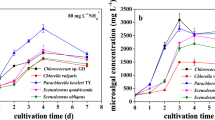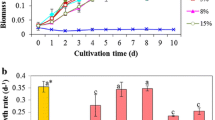Abstract
Enteromorpha linza (L.) J. Ag. was grown in full strength sewage effluent, various combinations of sewage effluent and seawater, and in natural seawater. It was found that full strength sewage effluent with a salinity of 14‰ supported best growth of the alga. After a 12 day cultivation period, growth ofE. linza in full strength sewage effluent and 75% sewage effluent- seawater mixture showed 3.5-fold and 2-fold increase in fresh weight over that grown in natural seawater; respectively. Uptake of PO sup3−inf4 -P, NH3-N and NO sup−inf3 -N by cells ofE. linza was extremely efficient in all tested media. Data obtained from the experiments indicated that inorganic nitrogen rather than phosphorus was the limiting nutrient factor for growth ofE. linza in full strength sewage effluent and in other sewage effluent- seawater mixtures. NH3-N at concentrations above 4.5 ppm was found to inhibit uptake of NO sup−inf3 -N in the same culture medium by the algal cells. The fact that sewage grownE. linza contained comparatively much higher protein content (30.2% dry weight) than that grown in natural seawater (12.5% dry weight) leads to the conclusion that sewage grownE. linza could serve as an economically feasible feed for livestock in Hong Kong where the sewage is characterized by having a salinity of approximately 14‰. It is proposed that this multicellular green alga is a suitable algal species to serve the dual function of wastewater purification through the production of algal protein from sewage effluent having high salinities.
Similar content being viewed by others
References
American Public Health Association, 1971. Standard Methods for the Examination of Water and Wastewater, 13th edn. APHA, New York.
Association of Official Analytical Chemists, 1975. Official Methods of Analysis, 12th edn. AOAC, Washington, D.C.
Chan, Kwong-yu, Wong, K. H. & Wong, P. K., 1979. Nitrogen and phosphorus removal from sewage effluent with high salinity by Chlorella salina. Envir. Pollut. 18: 139–146.
Chapman, V. J., 1970. Seaweeds and their Uses, 2nd edn. Methuen, London.
Environmental Protection Agency, 1971. Methods for Chemical Analysis of Water and Wastewater. Water Quality Officer, Analytical Control Laboratory, Cincinnati, Ohio.
Gilbert, T. R. & Clay, A. M., 1973. Determination of ammonia in aquaria and in sea water using the ammonia electrode. Analyt. Chem. 45: 1757–1759.
Goldman, J. C., Tenure, K. R., Ryther, J. H. & Corwin, N., 1974. Inorganic nitrogen removal in a combined tertiary treatment-marine aquaculture system — I. Removal efficiencies. Wat. Res. 8: 45–54.
Hong Kong Baptist College, 1976. Final summary report of a baseline aquatic environmental investigation in the area around the Dow Chemical Tsing Yi Island Polystyrene Plant in the period October 1974 to October 1975. Hong Kong Baptist College, Hong Kong. 197 pp.
Kueh, C. S. W., 1974. An investigation on the nutrients, coliform bacteria and other indicators of marine pollution in Tolo Harbour, Hong Kong. Hong Kong Fish. Bull. 4: 115–124.
Losada, M., Paneque, S., Vega, P. J. M., Cardenas, J. & Herrera, J., 1970. Inactivation and repression by ammonium of the nitrate reducing system in Chlorella. Biochem. biophys. Res. Commun. 38: 1009–1015.
Prince, J. S., 1974. Nutrient assimilation and growth of some seaweeds in mixtures of sea water and secondary sewage treatment effluents. Aquaculture 4: 69–79.
Reed, R. H. & Russell, G., 1979. Adaptation to salinity stress in populations of Enteromorpha intestinalis (L.) Link. Estuar. Coast. Mar. Sci. 8: 251–258.
Ryther, J. H. & Dunstan, W. M., 1971. Nitrogen, phosphorus and eutrophication in the coastal marine environment. Science 171: 1008–1013.
Steffensen, D. A., 1976. The effect of nutrient enrichment and temperature on the growth in culture of Ulva lactuca L. Aquat. Bot. 2: 337–351.
Tewari, A., 1972. The effect of sewage pollution on Enteromorpha prolifera var. tubulosa growing under natural habitat. Bot. Mar. 15: 167.
Tewari, A., Rao, M. P. & Krishnamurthy, V., 1968. Chemical composition of a species of Porphyra from Visakapathnam, South India. Curr. Sci. 37: 138–139.
Tsai, S. H., 1980. Micro-nutrients inedible seawoods. Food Ind. mon. 12: 24–30.
Author information
Authors and Affiliations
Rights and permissions
About this article
Cite this article
Chan, Ky., Wong, P.K. & Ng, S.L. Growth ofEnteromorpha linza in sewage effluent and sewage effluent-seawater mixtures. Hydrobiologia 97, 9–13 (1982). https://doi.org/10.1007/BF00014955
Received:
Revised:
Issue Date:
DOI: https://doi.org/10.1007/BF00014955




